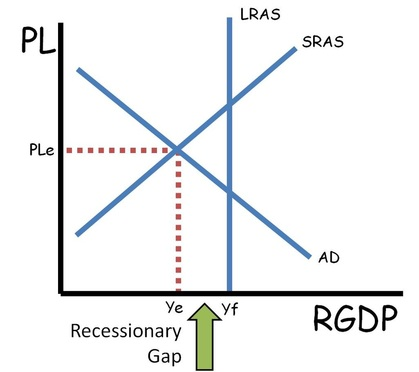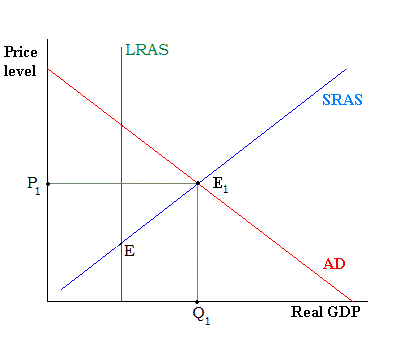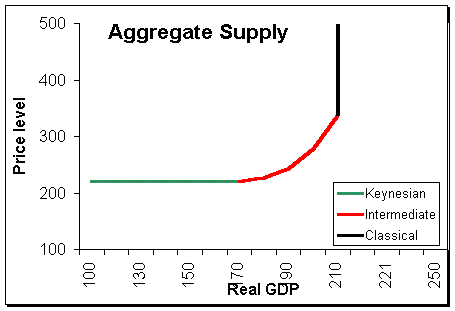AP MACRO UNIT 3
1/32
Earn XP
Description and Tags
Name | Mastery | Learn | Test | Matching | Spaced |
|---|
No study sessions yet.
33 Terms
Aggregate Demand (Curve)
The total demand for all goods and services in a particular market.
Real Wealth Effect
When people feel wealthier, they spend more money, which increases the flow of money in the economy
Higher price levels reduce the purchasing power of money. This decreases the quantity of expenditures
Lower price levels increase purchasing power and increase expenditures
Interest Rate Effect
When the price level increases, lenders need to charge higher interest rates to get a REAL return on their loans
Higher interest rates discourage consumer spending and business investment
Foreign Trade Effect
When US price level rises, foreign buyers purchase fewer US goods and Americans buy more foreign goods
Exports fall and imports rise causing real GDP demanded to fall (Xn Decreases)
Example: If prices triple in the US, Canada will no longer buy US goods causing quantity demanded of US products to fall.
So…price level goes up, GDP demanded goes down
the multiplier effect
shows how much spending is magnified in the economy
Expenditure Multiplier
Ratio of change in money (1/MPS)
Tax Multipier
(MPC)/1-(MPC)
Marginal propensity to consume (MPC)
Proportion of disposable income that is spent versus being saved (DI = MPS - MPC)
Marginal propensity to save (MPS)
Proportion of disposable income that is saved versus being spent (DI = MPS - MPC)
Short Run Aggregate Supply (SRAS)
Relationship between the Aggregate supply and the Aggregate demand, often falls victim to shocks.
Equilibrium price level
Point where SRAS, AD, and Yf intersect, shows position in which the economy is stable and at full employment/efficiency
Equilibrium real output
Level of GDP where SRAS is equal to AD, no excess supply or demand
Sticky wages
When wages of workers stagnate and do not change with inflating economy, can make labor cheaper
Long-run Aggregate supply
represents the total output an economy can produce when all resources are fully employed, and is determined by factors like technology, labor, and capital, not by the price level.
Recessionary gap
When an economy is less than fully employed, if the base of the triangle is on the right
Output low and unemployment is more than NRU

Inflationary gap
When an economy is more than fully employed, if the base of the triangle is on the left
Output is high and unemployment is less than NRU

Positive vs. Negative Supply Shock
Sudden increases or decreases in SRAS
Demand-pull vs. Cost-push inflation
When AD shifts vs. When SRAS shifts and causes inflation
Government transfers
Payment of money by the government where no goods are expected in return (Unemployment money)
Expansionary fiscal policy
Laws that reduce unemployment and increase GDP (Close a Recessionary Gap)
Increase Government Spending
Decrease Taxes (Increasing disposable income)
Combinations of the Two
Contractionary fiscal policy
Laws that reduce inflation, decrease GDP (Close a Inflationary Gap)
Decrease Government Spending
Increase Taxes (Decreasing disposable income)
Combinations of the Two
Stagflation
inflation increases while economic growth decreases
capital stock
Machinery and tools purchased by businesses that increase their output
classical theory
A change in AD will not change output even in the short run because prices of resources (wages) are very flexible.
AS is vertical so AD can’t increase without causing inflation.
keynesian theory
A decrease in AD will lead to a persistent recession because prices of resources (wages) are NOT flexible.
Increase in AD during a recession doesn’t cause inflation
ranges of AS
Keynesian Range- Horizontal at low output
Intermediate Range- Upward sloping
Classical Range- Vertical at Physical Capacity

autonomous consumption
consumers will spend a certain amount no matter what, regardless of of their income
disposable income
leftover income after taxes (consumers can spend with this)
dissaving/ negative savings
If income is less than autonomous spending
fiscal policy
Actions by Congress to stabilize the economy
monetary policy
Actions by the Federal Reserve Bank to stabilize the economy
discretionary fiscal policy
Congress creates a new bill that is designed to change AD through government spending or taxation
Problem is: time lags due to bureaucracy.
Takes time for Congress to act
Ex: In a recession, Congress increase spending.
non-discretionary fiscal policy
AKA: Automatic Stabilizers
Permanent spending or taxation laws enacted to work counter cyclically to stabilize the economy
Ex: Welfare, Unemployment, Min. Wage, etc.
When there is high unemployment, unemployment benefits to citizens increase consumer spending.